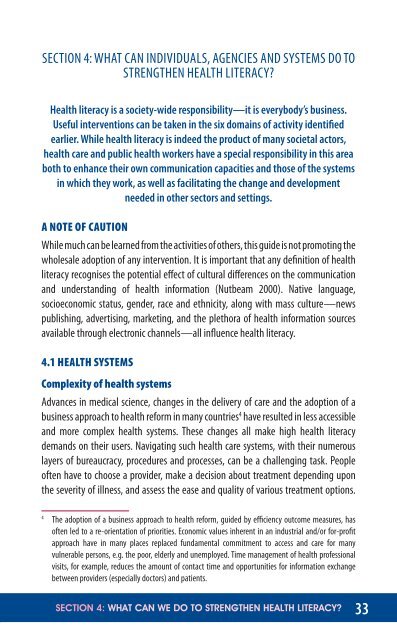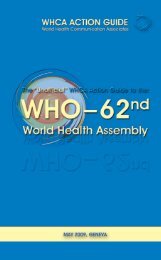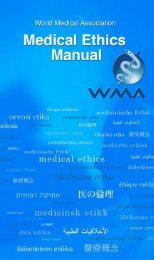the basics - World Health Communication Associates
the basics - World Health Communication Associates
the basics - World Health Communication Associates
- No tags were found...
You also want an ePaper? Increase the reach of your titles
YUMPU automatically turns print PDFs into web optimized ePapers that Google loves.
SECTION 4: WHAT CAN INDIVIDUALS, AGENCIES AND SYSTEMS DO TOSTRENGTHEN HEALTH LITERACY?<strong>Health</strong> literacy is a society-wide responsibility—it is everybody’s business.Useful interventions can be taken in <strong>the</strong> six domains of activity identifiedearlier. While health literacy is indeed <strong>the</strong> product of many societal actors,health care and public health workers have a special responsibility in this areaboth to enhance <strong>the</strong>ir own communication capacities and those of <strong>the</strong> systemsin which <strong>the</strong>y work, as well as facilitating <strong>the</strong> change and developmentneeded in o<strong>the</strong>r sectors and settings.A NOTE OF CAUTIONWhile much can be learned from <strong>the</strong> activities of o<strong>the</strong>rs, this guide is not promoting <strong>the</strong>wholesale adoption of any intervention. It is important that any definition of healthliteracy recognises <strong>the</strong> potential effect of cultural differences on <strong>the</strong> communicationand understanding of health information (Nutbeam 2000). Native language,socioeconomic status, gender, race and ethnicity, along with mass culture—newspublishing, advertising, marketing, and <strong>the</strong> plethora of health information sourcesavailable through electronic channels—all influence health literacy.4.1 HEALTH SYSTEMSComplexity of health systemsAdvances in medical science, changes in <strong>the</strong> delivery of care and <strong>the</strong> adoption of abusiness approach to health reform in many countries 4 have resulted in less accessibleand more complex health systems. These changes all make high health literacydemands on <strong>the</strong>ir users. Navigating such health care systems, with <strong>the</strong>ir numerouslayers of bureaucracy, procedures and processes, can be a challenging task. Peopleoften have to choose a provider, make a decision about treatment depending upon<strong>the</strong> severity of illness, and assess <strong>the</strong> ease and quality of various treatment options.4The adoption of a business approach to health reform, guided by efficiency outcome measures, hasoften led to a re-orientation of priorities. Economic values inherent in an industrial and/or for-profitapproach have in many places replaced fundamental commitment to access and care for manyvulnerable persons, e.g. <strong>the</strong> poor, elderly and unemployed. Time management of health professionalvisits, for example, reduces <strong>the</strong> amount of contact time and opportunities for information exchangebetween providers (especially doctors) and patients.SECTION SECTION 4: WHAT 3: CAN HOW WE IS DO HEALTH TO STRENGTHEN LITERACY MEASURED? HEALTH LITERACY? 33






